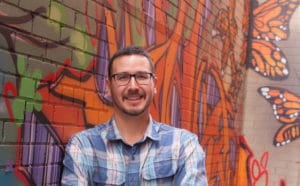Methamphetamine-related harms vary across Canada. Our west coast has obviously been hit hard, as British Columbia and Alberta have suffered many deaths. But there’s another province that gets less attention. Saskatchewan, in the center of our country, has been severely impacted by the harms of meth dependence, including associated, alarming rates of new HIV transmission.
Harm reduction has been widely effective in spreading knowledge and resources to prevent transmission of HIV and hepatitis C virus (HCV) through injection drug use. But when it comes to smoking supplies, it’s often a different story.
As a former crack cocaine user, I’ve been on both ends of sharing a glass stem. I know how people experiencing stimulant dependency may be more inclined to take risks, like sharing pipes or having unprotected sex. So I’ve been excited to learn more about a project in Saskatoon, Saskatchewan’s largest city, that includes a center for safely smoking substances.
The outside of the building features a large mural of a naloxone kit. It is home to AIDS Saskatoon, a community-based harm reduction organization providing innovative, progressive services even in the time of COVID-19. These include community outreach and drop-in services, a needle and syringe program, a nutrition program and weekly support meetings.
It developed the mission of opening a safe consumption site—including, within it, a state-of-the-art safe inhalation site.
Led by Executive Director Jason Mercredi, AIDS Saskatoon moved to its current location in November 2019, and the drop-in center’s attendance has since doubled. Benefits to those attending have been clear; clients are engaged, for example, with social supports such as housing, income assistance and legal support. Even the police have stated, “There have been fewer discarded needles, less garbage and less loitering.”
But AIDS Saskatoon wanted to do more in light of severe crystal meth-related problems. So it developed the mission of opening a safe consumption site at the center to reduce the harms associated with drug use—including, within it, a state-of-the-art safe inhalation site.
The renovated site has stainless steel booths for people to inject, snort or orally consume their drugs. It includes a separate room, with internal windows bringing in light and making everything visible, for people who are smoking their drugs. The air-intake ducts in that room are more powerful than those above the cubicles, allowing for air in the room to be more rapidly cycled out.

How does a safe consumption site differ from a safe injection site? Simple: It’s inclusive of all drug users. In the true harm reduction spirit, AIDS Saskatoon wants its space to welcome and support people who use drugs in whatever ways they choose.
“It’s so discriminatory to have it so only certain drug users can use your building.” Mercredi told Filter. “People’s drug use habits change, so if you don’t set your building up so they can adapt to the changes, it could mean that they die. Let’s set it up so it can handle everyone.”
As someone who has both smoked and injected various substances, I fully agree that every safe consumption site should at a minimum have an inhalation booth—there has always been a need. But people who smoke drugs are often denied access because it’s seen as less risky or deserving of care than injecting.
“If we didn’t start with a smoking space, we knew we would have to [build one] eventually,” Mercredi said.
Impacts of COVID-19
Unfortunately, however, the gleaming new consumption site has yet to accept visitors. COVID-19 has negatively impacted decision-making over funding, hampering service provision.
At the same time, the virus has presented a new, smoking-specific fear. “As you know, a lot of people when they smoke their drugs they share their pipes,” Mercredi said. He pointed out that “smoking has always been safer” than injecting, but asked, “Now, with COVID, is it?”
He was referring to the fact that COVID-19 can spread through saliva droplets, meaning that people who smoke and share drugs could potentially be at higher risk of contracting it.
One of AIDS Saskatoon’s responses to the pandemic was to work with the Saskatchewan Health Authority in setting up a walk-in COVID-19 testing site for people who use drugs. “As far as I know, we are one of the first in Canada to do so,” Mercredi said.
Carli Down is AIDS Saskatoon’s operations manager, and has been keeping an eye on what’s going on in the community. She relayed to me from a client, in order to protect his confidentiality, that he had two big concerns right now.
The first related to disruptions to the illicit market related to the pandemic: “He was extremely concerned with the lack of access to drugs and [the local supply’s] increasing potency,” Down said.
The second was how the response to COVID-19 has made people’s drug use change: “He witnessed an overdose in the community; it did not result in death.”
“We saw a big spike in overdoses since COVID-19 hit; we basically quadrupled our naloxone distribution.”
Saskatoon has experienced crystal meth-related harms since long before COVID-19, with a surge beginning in around 2013. Its large Indigenous population, in particular, has suffered disproportionate meth harms and HIV rates, and is probably most at risk from COVID-19. (Saskatchewan, mostly sparsely populated, had at publication time seen 658 coronavirus cases and 13 confirmed deaths.)
“We definitely have people still smoking drugs,” Mercredi said. But he speculated that some who share smoking supplies might see it as safer right now to inject. It’s the kind of fluidity between modes of use that an all-inclusive consumption facility could best serve.
But the pandemic has put the brakes on the site. Late last year, Saskatchewan’s Minister of Health was open to hearing ideas about funding for the operation of AIDS Saskatoon’s new facility. It looked pretty hopeful, and AIDS Saskatoon paid for its own renovations in preparation, while continuing to provide other services.
These include an intensive family support program in partnership with the Ministry of Social Services, working to support pregnant women who are seen as at-risk. The aim, said Mercredi, is “to ensure children stay in their home safely. We do a lot of safety planning and communication and trust is key to the program’s success.”
This is clearly an organization that can properly run a facility. But even though Health Canada granted AIDS Saskatoon a subsection 56.1 exemption—allowing people to legally consume substances via injection, inhalation or intranasal consumption at its center—that doesn’t come with funding, nor does it push the government’s hand to provide sustainable funding.
As the coronavirus hit, the province denied the funding necessary to staff and operate AIDS Saskatoon’s all-purpose consumption site. The COVID-19 response had become the overriding priority—yet safer drug use options should be seen as part of such a response.
“We are asking the government to look at things a completely different way,” Mercredi said. “There is a real cost associated with setting up an SCS and safer smoking room. When I talk to the public, they always go back to the cost. [But] I don’t give a fuck about your excuses, let’s figure out solutions.”

Jason Mercredi
“The [denial of] funding was definitely a blow but it’s not the end,” he continued. “We are in this for the long haul; we’re going to get our way, one way or another. This shit needs to happen. We are sick of the status quo.”
Available evidence suggests that drug-involved deaths in general are increasing at this time. “We saw a big spike in overdoses since COVID-19 hit; we basically quadrupled our naloxone distribution,” Mercredi said. In Regina, Saskatchewan’s capital, there have been 233 overdose events known to Regina Police Services, with 11 confirmed fatalities, since January 1.
But Mercredi anticipates being able to improve his organization’s response soon. “Now that we’re starting to get back to normal in the province, we’re going to be looking at opening the second half of 2020,” he said, confirming that this will happen “come hell or high water,” with or without provincial funding—though having the funding would clearly make things easier.
I had the pleasure of meeting Jason Mercredi a few times right before the world went on lockdown. As a drug user, I know he’s the type of person I would want fighting for me and my community. Mercredi, who is First Nations and Metis, is in this work for all the right reasons—but the biggest reason of all, as he puts it, is that “I’m done burying my clients.”
Photographs courtesy of AIDS Saskatoon
"consumption" - Google News
June 11, 2020 at 08:51PM
https://ift.tt/30vMyL5
Safe Consumption Means Safe Inhalation, Too: An All-Inclusive Model - Filter
"consumption" - Google News
https://ift.tt/2WkKCBC
https://ift.tt/2YCP29R
Bagikan Berita Ini














0 Response to "Safe Consumption Means Safe Inhalation, Too: An All-Inclusive Model - Filter"
Post a Comment